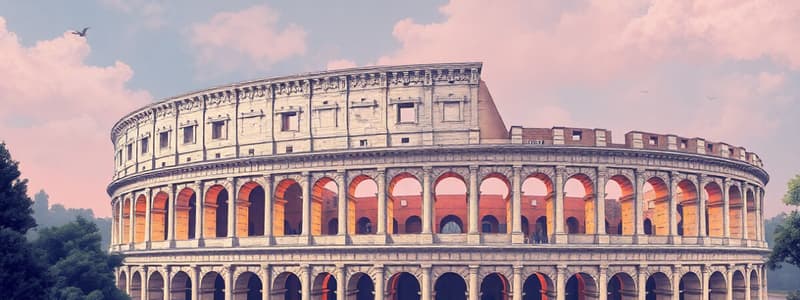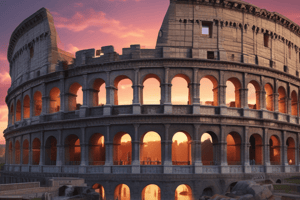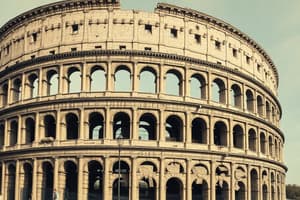Podcast
Questions and Answers
Why was the Flavian Amphitheater eventually renamed the Colosseum?
Why was the Flavian Amphitheater eventually renamed the Colosseum?
- Because of its proximity to a large statue of Nero. (correct)
- To celebrate the Flavian Dynasty's military victories.
- To reflect its primary use as a site for animal hunts (**colosse**um means large in ancient latin).
- To honor Emperor Titus, who completed its construction.
Which architectural innovation was most crucial for the construction of the Colosseum's complex structure?
Which architectural innovation was most crucial for the construction of the Colosseum's complex structure?
- The use of marble for seating.
- The implementation of barrel vaulted corridors. (correct)
- The integration of Greek columns.
- The design of numbered gateways.
What determined where spectators sat in the Colosseum?
What determined where spectators sat in the Colosseum?
- Social hierarchy. (correct)
- Physical strength and combat skills.
- Ticket price.
- Random selection.
How did the Colosseum's substructure contribute to the spectacles within the arena?
How did the Colosseum's substructure contribute to the spectacles within the arena?
What happened to the Colosseum after the fall of Rome?
What happened to the Colosseum after the fall of Rome?
The Colosseum was constructed during the Flavian Dynasty. Which of the following describes the order of succession during the building of the Colosseum?
The Colosseum was constructed during the Flavian Dynasty. Which of the following describes the order of succession during the building of the Colosseum?
Examine the facade of the Colosseum. What is the correct sequence of the Greek orders from the ground up?
Examine the facade of the Colosseum. What is the correct sequence of the Greek orders from the ground up?
What was the primary role of gladiators within the spectacles held at the Colosseum?
What was the primary role of gladiators within the spectacles held at the Colosseum?
Flashcards
Flavian Amphitheater
Flavian Amphitheater
Original name of the Colosseum, named after the Flavian Dynasty.
Colossus of Nero
Colossus of Nero
Large statue of Nero near the Colosseum, after which the Colosseum was later named.
Vespasian
Vespasian
Emperor who began the construction of the Colosseum.
80 A.D.
80 A.D.
Signup and view all the flashcards
Gladiators
Gladiators
Signup and view all the flashcards
Numbered gateways
Numbered gateways
Signup and view all the flashcards
Substructures
Substructures
Signup and view all the flashcards
Concrete
Concrete
Signup and view all the flashcards
Study Notes
- Located in Rome, Italy
- Originally named the Flavian Amphitheater
- Renamed for its location beside the Colossus of Nero
- Nero's statue was 120 feet tall and stood at the entrance to his urban villa
- Built in a 10-year period, starting in 70 A.D.
- The Flavian Dynasty ruled Rome for over a quarter century, starting with Emperor Vespasian
- Vespasian's first project as Emperor was the Flavian Amphitheater
- The Flavian family paid for its construction
- Completed in 80 A.D. under Vespasian's son, Titus
- Held over 50,000 spectators
Purpose
- Used as an amphitheater where thousands of people and animals were killed
- Featured gladiatorial combats and animal hunts
- Gladiators were professional fighters, often slaves
- Helpless prisoners and wild animals were used in hunts
- Animals were pitted against each other for entertainment
- Numbered gateways allowed efficient entrance and exit
- Spectators were seated according to social hierarchy; elite closest to the arena, commoners at the top
Substructure
- Hidden substructures beneath the arena floor housed waiting rooms and animal cages
- Machinery raised and lowered stage sets, animals, and humans
- Built with a barrel vaulted corridors, held up the oval seating area
- Served as a convenient quarry for ready-made building materials after the fall of Rome
- Marble seats were hauled away, revealing the vaults below
Travertine Shell
- Exterior is approximately 160 feet high, about the height of a 16-story building
- Facade includes Roman arches and Greek columns
- Divided into four bands with arched openings in the lower three
- Ornamental Greek orders frame the arches in a standard Roman sequence
- From the ground up: Tuscan, Ionic, and then Corinthian
- Framing and arch with Greek order added variety, not structural support
- Multi-storied facade is unified by casting verticals and horizontals
- Represents Rome to most people today
Studying That Suits You
Use AI to generate personalized quizzes and flashcards to suit your learning preferences.
Related Documents
Description
The Colosseum, originally the Flavian Amphitheater, was renamed for its location near the Colossus of Nero. Construction began around 70 A.D. under Emperor Vespasian and was completed in 80 A.D. It hosted gladiatorial combats and animal hunts, accommodating over 50,000 spectators.




